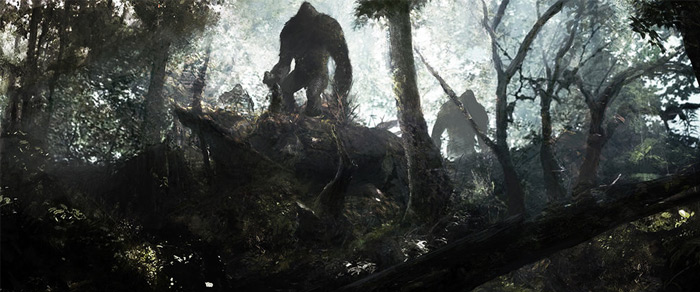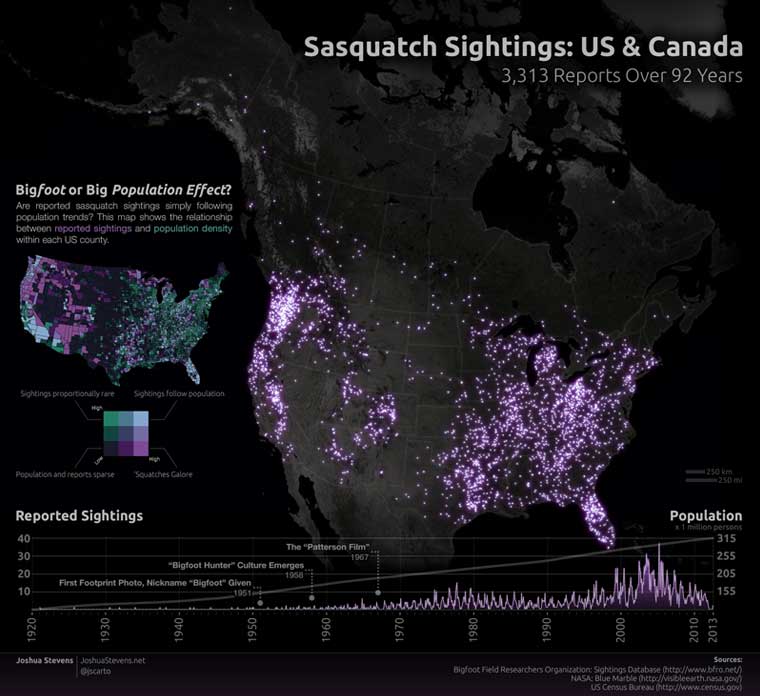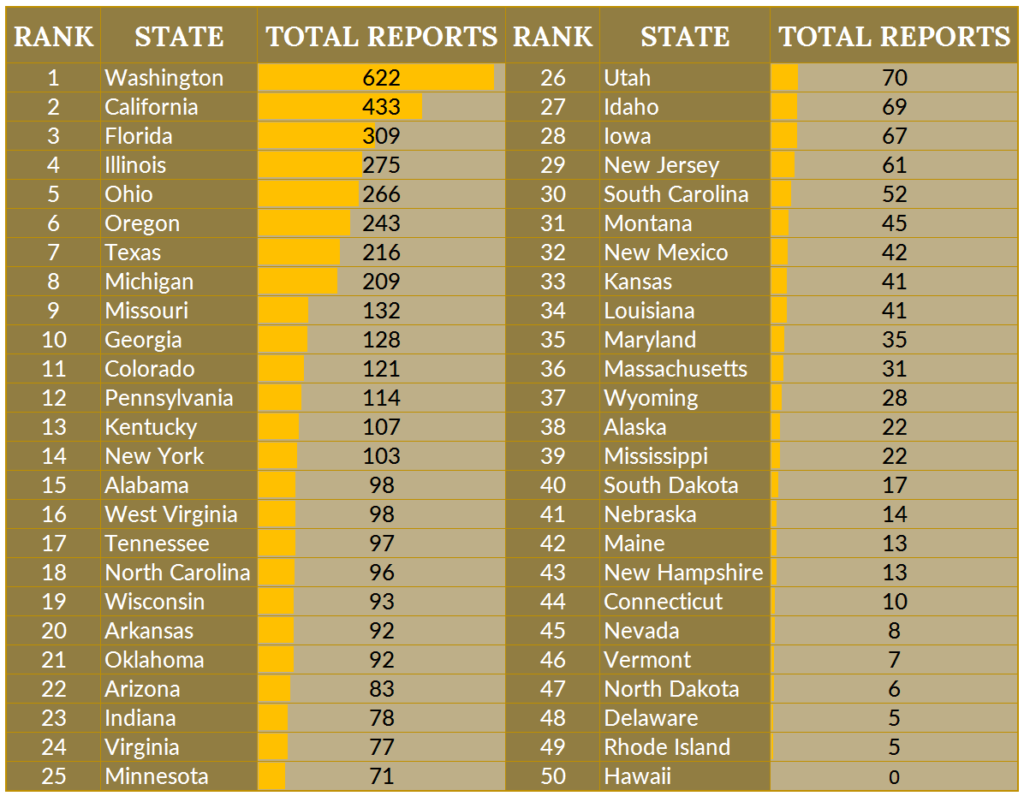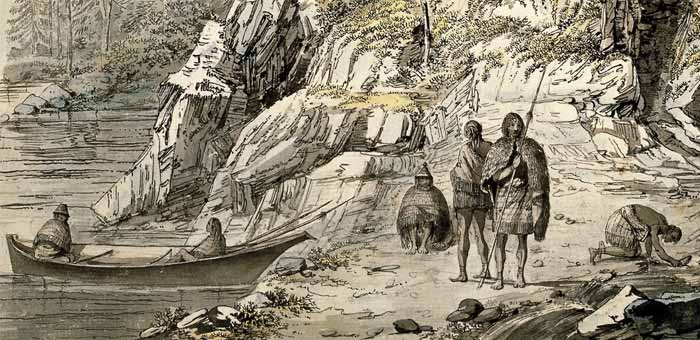In North America, reports of Bigfoot-like creatures come from all over: Mount St. Helens to North Carolina; Alaska to Arkansas and every state between… even Hawaii. Witnesses see them on every continent except for Antarctica. The true scale of this phenomenon is impressive to say the least.

‘Bigfoot Reunion’ by Sebastien-Ecosse
Little by little I believe in the idea that these bipedal, hairy, massive phantoms could inhabit ANY remote or highly inaccessible wilderness area. But where specifically would Bigfoot live?
Warning, this article attempts to analyze the distribution and habitat of a yet-undiscovered species. Trying to shape strong hypotheses with nothing more than anecdotal evidence and speculation based on ‘similar’ animals should not be taken serious. This is all just Bigfoot-flavored food for thought. That’s all we can do with such limited information, think.
JUMP TO… Where Does Bigfoot Live in the U.S. & Canada? | What Kind of Setting Would Bigfoot Require? | Where Would Bigfoot Sleep? | Historical Accounts of Bigfoot Settlements
Where Does Bigfoot Live in the United States & Canada?
The short answer? Anywhere. But there are certain places where Bigfoot is commonly considered to live:
Mount St. Helens, Washington
Nestled in the Cascade mountain range in Washington, Mount St. Helens is best known for its incredible 1980 eruption. 57 people died in debris avalanches, structure collapses, and smoke inhalation. This includes countless injuries and millions of dollars-worth of destruction. Amazingly, stories persist to this day of several Sasquatch perishing on the mountain and surrounding country. Some witnesses claim they observed army helicopters airlifting massive dead bodies away from the smoking landscape.
Many believe that a maze of lava tubes snake below Mount St. Helens and throughout the Cascades. These tunnels would offer miles of underground shelter for large animals, perhaps even Sasquatch. The state of Washington features the most Bigfoot sightings in the United States, by far. Intricate cave systems and the expansive, remote wilderness make Washington Bigfoot capital of the United States.
The Everglades National Park, Florida
A lot of people overlook states outside of the Pacific Northwest as prime Bigfoot habitats. Many people don’t realize that Florida ranks in the top five of state-by-state sightings. Miles and miles of remote, impenetrable swampland and a huge food surplus creates a fantastic habitat for a large omniverous mammmal like Sasquatch.
But down in Florida you won’t find Sasquatch. You’ll find Skunk Apes. In dense and expansive territories like the Everglades National Park and Myakka State Park, witnesses describe a putrid smelling, lithe, black-haired ape-man. These creatures contrast the hulking, barrel-chested brutes of the Pacific Northwest. The southern body types likely have stark differences due to a more limited population size (smaller territory), a unique swamp diet, and the amount of time spent living in the water.
Salt Fork State Park, Ohio
A true midwestern hot spot, Salt Fork State Park in central Ohio boasts dozens of compelling Bigfoot sightings. The largest in Ohio, this state park features 17,000 acres of majorly uninhabited land, and 8,000 acres of lakes and waterways. Ohio is another greatly overlooked state for encounters. The state is ranked 7th in overall population, but most Ohio residents live in close to large cities throughout the state. This means that there’s still a lot of sprawling, low-traffic, food-rich country in the Buckeye state. Ohio also features a vast river system with countless tributaries and smaller waterways. Salt Fork is kind of a vortex of many of these waterways. It is also right on the edge of the Appalachian Plateau, which is sort of a gateway to the Appalachian Mountain Range. Many Bigfoot researchers believe that this range is a Sasquatch super highway, trekked annually by these creatures as they follow seasonal food sources.
Salt Fork is also the site of several popular Bigfoot conferences like the Ohio Bigfoot Conference, the Annual Bigfoot Conference. Researchers also hold monthly Bigfoot night hikes and creature weekends in the park.
Considering Population Size
Let’s try to hammer down where these creatures might establish their geographic territory. Knowing that sightings occur all over the globe and throughout the United States & Canada, let’s try to magnify what kind of area these creatures would prefer to settle.
First let’s consider a sustainable population number.
There’s definitely not one Bigfoot. There’s not even a hundred Bigfoot. The minimum viable species amount for gorillas is somewhere between 842 and 11,919. This means that unless the total amount of gorillas dipped beneath 842, the species would be just fine. I cite gorillas assuming Sasquatch are actually great apes as well. Conceivably, these creatures would need similar numbers to exist in the world, unless they’re slowly dropping off– which is possible. The Bigfoot Field Researchers Organization (BFRO) provides a general estimate of 2000-6000 Bigfoot in North America.
Estimating population size is beyond speculative. Researchers have a hard enough time determining the required breeding population of known animals, let alone one they’ve never been able to even get close to. So where would a few thousand Bigfoot live in North America? And WHERE exactly would they settle?
Where do sightings take place overall?
Let’s take a narrowed look at North America sightings and try to drill down from there. This fantastic map from Josh Stevens plots 3,313 Bigfoot sightings between 1921 and 2013. He looks at the relationship between reported sightings and population density within each county in the United States. Utilizing all reputable data from the BFRO, Stevens notes that sightings in the midwest and east coast, while numerous, are actually proportionally rare or follow the population. Per Josh, “There are distinct regions where sightings are incredibly common, despite a very sparse population. On the other hand, in some of the most densely populated areas Sasquatch sightings are exceedingly rare.”

Bigfoot sightings map by Josh Stevens
By the numbers, here’s the BFRO’s data on state-by-state reports up to November 2016. It is very possible that these creatures don’t habituate certain states, and the small number of sightings are mis-identifications and hoaxes. But, as the reports soar per state, I find it harder to believe that every single sighting is bunk.

What Kind of Setting Would Bigfoot Require?
1) Near a Reliable Water Source
Let’s go out on a limb and decide that Bigfoot drink freshwater like every other red-blooded American. Topping the list of basic needs, the need for water should place them at all times within a few miles of a known source, likely an area that is dependable. In California, for example, drought conditions frequently dry up streams and creeks. It would make more sense that they set up shop near a pond or lake that only recedes gradually. I would imagine them to take full advantage of mountain springs as well.
2) Near a Reliable Food Source
Apes aren’t known to migrate. They are more territorial animals. Likely, when food opportunities arise, Sasquatch wander to distant areas and make temporary settlement. They may maintain a small number of ‘homes’ in an ideal, base-locale, like a cave near a water source. Some suggest that “the Sasquatch are ‘slick opportunists’ in that they know instinctively where and when certain fruits ripen, crops mature, the salmon run, birds nest and the herds calve.” So let’s not project the desires/needs of MAN onto an animal. Sasquatch don’t go fishing for fun or hike for their health. There’s no reason why they wouldn’t be extremely familiar with available food sources in a 50 mile radius. That’s their purpose: to live.¹
I think that they are intelligent enough to remember previous temporary settlements and return to those spots when food sources become available. Perhaps they stay in that general area for a few days, or weeks to gather food for a cache and move on to the next spot. Perhaps they have one truly dependable location that they can always return to. Those few places would also likely be the spot where the young and old reside.
3) In Reliable Shelters
Plenty of animals sleep out “under the stars” as we romantically put it. Plenty of large mammals construct ‘beds’ with grass and bark. I don’t doubt that Bigfoot does the same, but as an intelligent great ape who, in my opinion, has an innate need to NOT be seen or heard they probably utilize a bit more strategy when they’re going to be laying down for an extended period of time. This likely translates to settlements that allow for a quick escape, total or significant floral coverage, and ideally, high ground camps to assess dangers from afar.
Where Does Bigfoot Sleep?
1) Caves
There are easily hundreds of thousands of caves strewn throughout the United States. Over one-third of all counties in the country have at least one cave, and some have so many that they haven’t been properly indexed. Most karst/limestone caves dot the Appalachians, the Ohio valley, the Ozarks, and the Florida Lime Sinks: all top regions for Sasquatch sightings (see map above).
There are also psuedokarst caves, which are most often lava tubes. These types are most often found in the western United States. They can stretch miles long, winding about in knotted passages with multiple entrances. Mount Shasta in California supposedly features a ‘lost city’ of tubes amidst the volcano roots. A lost city of Sasquatch?! Probably not, but I’m sure there’s plenty of dark space to habituate up there.
Similarly, lava tubes spread beneath Mt. St. Helens in Washington. Just like Mt. Shasta, many believe the entire volcano, above and below, to be a major hotspot for Sasquatch colonies. Stories persist to this day of government helicopters scooping Bigfoot bodies off the mountain after the 1980 eruption. The mountain is also just two miles west of Ape Canyon: an infamous site in Bigfoot lore. In 1924, rock-throwing, shrieking ‘ape men’ terrorized five miners overnight. This event is commonly called ‘The Battle of Ape Canyon.’
2) Abandoned Mines
There are an estimated 500,000 abandoned hardrock mines in the United States. Most of them were hastily dug amid the country’s western gold rush. 500,000 empty mines: that’s a lot of uninhabited shelter space up in the mountains. Depending on surrounding terrain, I could definitely see Sasquatch settling inside. With that many mines, there’s bound to be hundreds of them found in especially remote areas. A perfect choice for a longterm Bigfoot home, no doubt.
3) Abandoned Homes
Shelter is shelter, you know? What would happen if a roaming Bigfoot came across a forgotten farmhouse way out in the country? I would think they’d look upon that house with a heap of optimism and settle in for a short time.
These creatures aren’t dumb. They won’t just walk into your Grandma’s house and take a nap. Houses and farms indicate human presence. They likely develop a comfort level with the structure and scout out human activity for a reasonable amount of time before settling in.
And once they do… welp, there goes the neighborhood.
4) Trees
Could an entire family of 800 lb apes live in a tree? I doubt it. Maybe one or two, but I don’t think that tree dwellings make sense. Certainly, I could see one resting high up in a tree, but do they even have the capability to climb after a certain age? Bears can comfortably scale a branchless pine tree with a nifty set of claws, but what would a Sasquatch do in that situation? They’re all fingers!
Gorillas live on the ground, but maintain great balance in the trees. While I don’t think many tree varieties would be sturdy enough to support a Bigfoot for a long stay, I think resting & foraging would work just fine.
Historical Accounts of Bigfoot Settlements
Usually it seems that Sasquatch finds you, or you glimpse one for two seconds as it rushes across a trail or road. Stories are rare in which a person or group stumbles into the ‘lair of the beast’, but we do have some notable historical tales that help paint a picture of an actual Bigfoot residence. Unfortunately for these two men, they became forced house-guests.
Albert Ostman’s Abduction
Perhaps the most well-known of Bigfoot abductions is the 1924 Albert Ostman story. Ostman, a Canadian prospector, claimed that he was carried off into the night by a Sasquatch while still nestled inside his sleeping bag. The creature carried him for miles and miles across the countryside. Hours passed before the abductor placed him on the ground. When Ostman crawled from the bag he discovered three more of these beings: a young boy & girl, and an old female. The abductor was like an old man. The family stood over Ostman chattering away in their own language. Ostman noted the geography of their dwelling:
“I could see now that I was in a small valley or basin about eight or ten acres, surrounded by high mountains, on the southeast side there was a V-shaped opening about eight feet wide at the bottom and about twenty feet high at the highest point — that must be the way I came in. But how will I get out? The old man was now sitting near this opening.”
Ostman lived with the creatures for six days. Though he had a weapon, he did not want to shoot the family, since they brought him no harm. As the days passed, Ostman studied their interpersonal dynamics and what perhaps brought them to this spot:
“I don’t think this valley was their permanent home. I think they move from place to place, as food is available in different localities. They might eat meat, but I never saw them eat meat, or do any cooking.” He added, “I think this was probably a stopover place and the plants with sweet roots on the mountain side might have been in season this time of the year. They seem to be most interested in them. The roots have a very sweet and satisfying taste. They always seem to do everything for a reason, wasted no time on anything they did not need.”
Ostman eventually escaped by offering the old man a box of snuff. The creature curiously ingested the tobacco, became sick, and did not pursue Ostman as he ran away.
Read the amazing full story at Bigfootencounters.com.
The Story of Muchalat Harry
In 1975 notable Bigfoot researcher Peter Byrne wrote ‘The Story of Muchalat Harry.’ A missionary priest named Father Anthony told him the story of a Nootka indian named Muchalat Harry who he rescued from the Conuma River. Near death, Muchalat Harry explained that he was abducted by a massive creature while trapping in the forests of Vancouver Island, British Columbia.
Much like the Albert Ostman tale, the creature came in the middle of the night and picked him up as he slept, wrapped in blankets. He was also carried for roughly three miles to a rocky settlement. Terrified, Muchalat Harry noted around twenty Bigfoot of all shapes and sizes. The group brought no harm, but poked and analyzed him out of pure curiosity.
When the sun rose, Muchalat Harry was able to understand his surroundings. The creatures made their craggy camp high up in the rising hills, beneath a high rock shelf. As the day passed most of the beings dispersed the site for one reason or another. When he finally escaped, Muchalat Harry ran for his life three miles downhill to his camp. He ran all the way passed his camp for twelve miles to the mouth of the Conuma River. There he canoed forty-five miles down ice-cold, winter rivers. When Father Anthony found him, he was near frozen and lifeless. Three weeks passed before he regained his health, still mentally shaken by his incredible ordeal.
Read the entire story at Bigfootencounters.com

‘Detail of a Nootka Sound’ watercolour by John Webber, 1778. Muchalat Harry was a Nootka indian reportedly abducted by Sasquatch
Ok, So Considering Everything… Where Does Bigfoot Live??
I would be willing to bet we’d find a Bigfoot in a remote, abandoned mine shaft within one mile of a lake in Washington state when berries are in full bloom.
K, see you there.
— AJ
Sources:
1 Short, Bobbie. “Sasquatch Migration – No Shortage of Opinions…” Bigfootencounters.com

Pingback: unc mama bear shirt
I live in Onalaska, Wisconsin. There is a swatch of wooded county land behind my house with a large stream running through it. My dog and I found a trail at the edge of the neighborhood park on November 5th, 2018. We followed the trail as it meandered parallel to the stream. The trees and undergrowth had lost their leaves. The little valley began to narrow. It was quiet. No squirrels bounding. No birds singing. On my right, roughly 15 yards away, I heard a deep toned, growl, on a long exhaled breath. I first thought it reminded me of my dad’s male German Shepherd dog. This “ voice” sounded like it came from a larger pair of lungs than King’s.
My dog sniffed the air, straining forward to follow a scent. The back of my neck went all prickly, and my heart was pounding. I retreated quickly, looking back often, frightened that I would see evidence that we were being chased.
All around us were silent trees. No wind, no bird or squirrel sounds. And erie vacuum with only the muffled, occasional rush of the stream over a fallen tree.
I went back today, but didn’t have the courage to go past the first open glade.
My yard touches the edge of this county land. I have often looked to the woods and had the feeling I was being watched. I never allow myself to be alone in the back yard after dark.
Please dont lie please tell me the truth i am investigating about bigfoot so we can see it to the world but that means not to harass them leave them to live their own ways because it also wants to live in peace .Ihave searched everywhere in google but most them means 1/2 were only true but blure and all the others were fake thanks for reading my comment and do not disturb the ecosystem because without it we are nothing so k friends bye.
I went fishing 15 years ago, a lake with a road separating it from a river, they’re 30 yards apart the lake I fish is under 100 acres. As I finished up and began my trek to the car I noticed a small rock about the size of a quarter fly over my right shoulder. No one around, that’s odd. Never forgot that and now I’ve learned more about Bigfoot behavior from shows and the web.
Flash forward… 2 months ago I went they’re again / I’ve since moved away /and thought let’s stop here and peek into the canopy of weeds, brush and trees waited about two minutes, nothing its 630 am well I might as well go fishing got about 20 yards away and something huge began moving through the brush away from me towards the river, I heard what can only be described as a tree break in half and turned around and thought my god is that a tractor going through the brush and as soon as I looked it stopped
I waited and hastily moved on. Wow I thought, what was that, too big to be a deer, no bear in Illinois?!! Don’t know if I’ll ever go back.
Awesome information once again! Thanks.
My theory is that they are nomadic. I have not seen one, but have heard the knocks,howls,and screams. I usually hear them in October,and then again in the spring. By the way, I live in Georgia.
My theory is that they are nomadic. I have not seen one, but have heard the knocks,howls,and screams. I usually hear them in October,and then again in the spring.
Aw, this was a very nice post. Taking a few minutes and actual effort to make a great article… but what can I say… I procrastinate a lot and never manage to get anything done.
I like the valuable info you provide in your articles. I’ll bookmark your
blog and check again here frequently. I am quite
certain I’ll learn many new stuff right here! Best of luck for the next!
I could not refrain from commenting. Exceptionally well written!
This is a topic that’s near to my heart…
I respect your work.
Great post. Have you thought about oceanside caves? Apparently they’ve been seen around beaches from people out on boats.
I once met a Bigfoot in a Burger King bathroom.
The San Juan river is located behind my home. I’ve heard their screams several times.